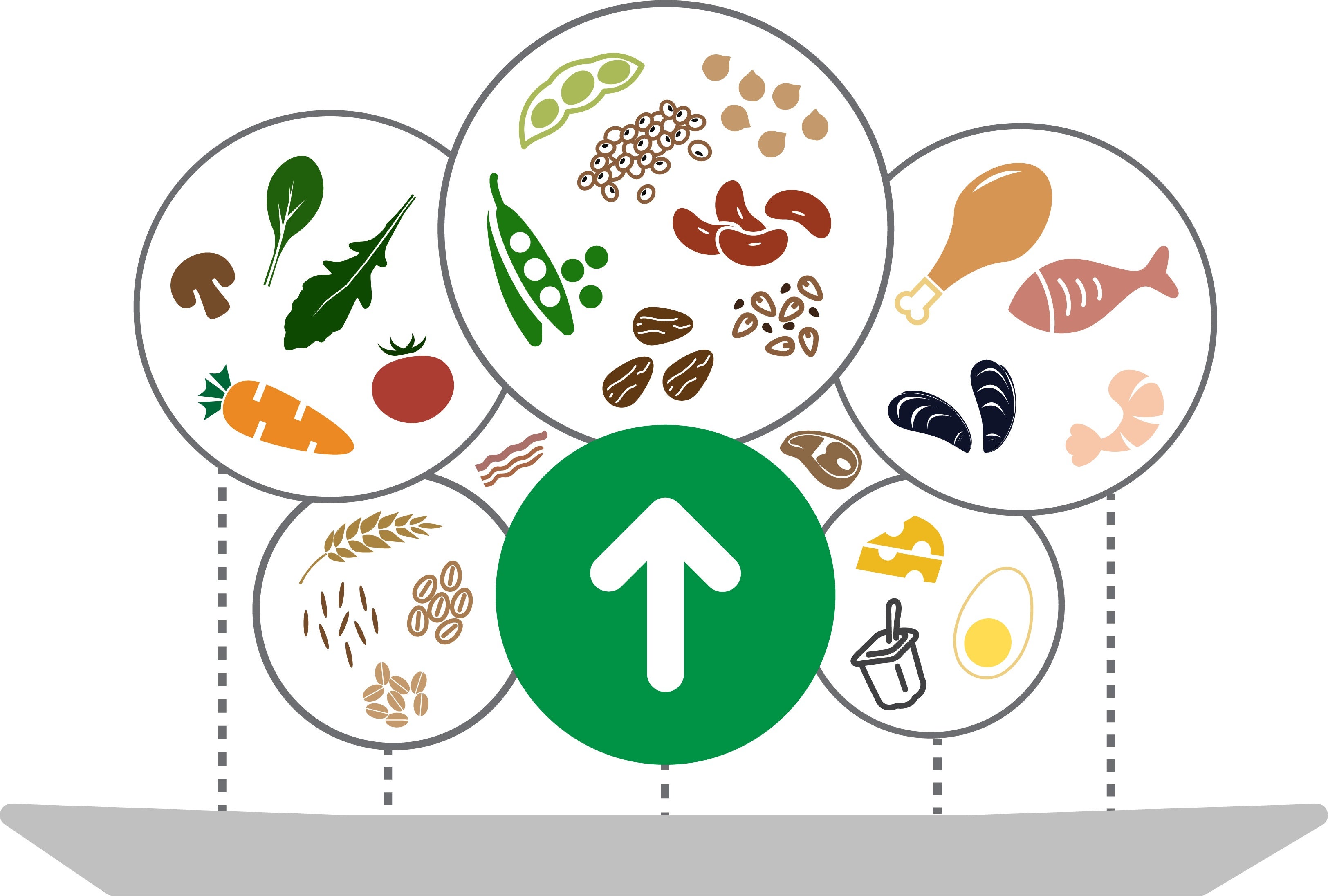If you grew up in the United States, a bell pepper, stuffed with ground beef, rice, tomatoes, and cheese is likely a familiar dish. It’s a basic recipe that goes way back, with two types of “stuffed peppers” even featured in Fannie Farmer’s 1896 Boston Cooking-School Cook Book.
Of course, the idea of stuffing a bell pepper (or other pepper varieties) undoubtedly precedes this 19th-century culinary text. Recipes for stuffed peppers can be found in cuisines all over the world—from Denmark’s “fyldte peberfrugter” (stuffed with bulgur, kale, and mushrooms) to India’s “bharwa shimla mich” (stuffed with a mixture of spiced vegetables).
Indeed, using a bell pepper as a vessel can yield an endless number of delicious and creative filling combinations. Plus, exploring beyond the basic beef and rice combo is a perfect way to try some strategies to reduce red meat and elevate your plate. Stuffed peppers are also perfect for meal prep, portable for lunchboxes, and generally freeze well too if you want to make a larger batch ahead of time.
If you aren’t familiar with this recipe, one serving typically packs about a quarter-pound of ground beef (sautéed with onion and mixed with white rice, tomato sauce, and mozzarella cheese) into a large bell pepper. Not really an optimal recipe for our health. Beyond the refined rice, this quantity of red meat combined with cheese serves up quite a bit of saturated fat—around 18 grams worth.
Ready to get cooking? Here are a few recipe ideas to get you started:
- The Upgraded Basic features minor tweaks to the basic beef, rice, and tomato version, creating a healthier recipe with no change in flavor.
- The New Classic sticks to the classic flavor profile, but incorporates a hearty and savory mixture of lentils and portabella mushrooms.
- Variations: This recipe also serves as a solid base for incorporating some favorite animal-based foods in small amounts, such as a bit of flavorful cheese or an egg baked on top of the filling.
- The Southwestern ventures into new flavor territory with a stuffing of spicy chicken, black beans, and a mixture of veggies.
The Upgraded Basic

Although a diet high in red meat is not optimal for our own health (or the planet’s health), just a few minor tweaks can upgrade this recipe without changing the flavor if you’re looking to enjoy it on occasion.
Compared to the typical “basic” stuffed bell pepper recipe, using lean ground beef at half the amount (and just a little less cheese) cuts the saturated fat per serving down to about 9 grams. You’re still getting plenty of protein—nearly 22 grams per serving. We also added a bit more rice, but switched to brown rice for a nutritious boost, and swapped out tomato sauce for diced tomatoes to add texture and reduce the sodium.
See the full recipe
"Upgraded Basic" Stuffed Peppers
- 4 large bell peppers
- 1 tablespoon olive oil
- 1/2 pound lean ground beef
- 1/2 cup minced white onion
- 2 cups fresh diced tomatoes (or 2 14.5-oz cans unsalted diced tomatoes, drained)
- 3/4 cup brown rice (yields just over 2 cups cooked)
- 1/4 teaspoon salt
- 1/4 teaspoon garlic powder
*1/4 teaspoon black pepper
- 1 cup shredded mozzarella
- To prepare the rice: rinse under cold water and drain thoroughly, and cook according to package instructions.
- Cut a thin slice from stem end of each pepper to remove the top. Scoop out the seeds and membrane.
- To prepare the peppers for baking, place them in a pot and fill the base with water (fill inside peppers with some water as well to avoid floating). Bring to a boil, then reduce temperature to medium-low and simmer 3 for minutes. Remove from pot and place in ice bath. Drain.
- Preheat oven to 350 degrees Fahrenheit.
- Heat the olive oil in a pan over medium heat. Add the onion and cook, stirring occasionally until softened, 2-3 minutes. Add the beef and cook, stirring occasionally until beef is cooked through (no longer pink), 6-7 minutes. Stir in cooked rice, diced tomatoes, salt, garlic powder, and black pepper. Remove from heat.
- Stuff Peppers with filling mixture and place in a baking dish.
- Bake for around 20 minutes. Peppers are ready if a toothpick or fork easily slides through the skin near the top of the pepper.
- Sprinkle with shredded mozzarella and bake for around 5 more minutes.
Nutrition facts:
Serves 4
431.5 calories
21.5 grams of protein
40.3 grams of carbohydrates
6.1 grams of fiber
7.8 grams of sugar
426.1 milligrams of sodium
258.1 milligrams of potassium
21.1 grams of fat
(
8.9 grams of saturated fat
7.6 grams of monounsaturated fat
0.8 grams of polyunsaturated fat
0.5 grams of trans fat
)
57.5 milligrams of cholesterol
This recipe showcases just one of the many ways to try eating a little less red meat. You can also try swapping for a healthier meat like poultry or seafood, and explore new flavors in the process (for example, this pepper stuffed with spicy chicken and black beans). Or, you can stick with the familiar flavor profile but try some savory and hearty plant-based proteins instead.
 The New Classic
The New Classic
True to its name, this recipe sticks to the classic taste of the “basic” stuffed pepper recipe—but with a new approach to those favorite flavors. Hearty lentils, savory portabella mushrooms, umami-packed tomatoes, and sautéed onions combine with brown rice to deliver a surprisingly “meaty” filling—but without the red meat.
At 12 grams of fiber and virtually no saturated fat per serving, this new classic is a major health upgrade. (Lentils are also known for helping replace nitrogen in the soil—an upgrade for the planet’s health as well!)
Even better is that this recipe provides a solid base for further modification. For example:
- If you want to increase the plant-based protein content from 14 grams to 21 grams per serving, mix a half-cup of hemp seeds or hemp hearts into the filling—boosting heart healthy unsaturated fats in the process.
- If you want to incorporate a bit of your favorite animal-based protein, you can sprinkle over some flavorful cheese; or, try cracking an egg on top of the filling before baking.
See the full recipe
"The New Classic" Stuffed Peppers
- 4 large bell peppers
- 2 tablespoons olive oil
- 1 ½ cups of brown or green lentils (or 3 3/4 cups, cooked)
- 2 ¼ cup low-sodium vegetable broth (omit if using pre-cooked lentils)
- 1 cup roughly chopped portabella mushrooms
- 1/2 cup minced white onion
- 2 cloves garlic, minced
- 2 cups fresh diced tomatoes (or 2 14.5-oz cans unsalted diced tomatoes, drained)
- 3/4 cup brown rice (yields just over 2 cups cooked)
- 1/4 teaspoon salt
- 1/4 teaspoon black pepper
- Dried herbs, to taste: basil, oregano, thyme
- OPTIONAL: add 1/2 cup hemp seeds or hemp hearts for a heartier meal that boosts protein and heart-healthy fats
- To prepare the lentils, cook according to package instructions, but use low- or no-sodium vegetable broth for extra flavor. 1 cup of dry lentils will yield around 2 ½ cups cooked lentils.
- To prepare the brown rice: rinse under cold water and drain thoroughly, and cook according to package instructions.
- Cut a thin slice from stem end of each pepper to remove the top. Scoop out the seeds and membrane.
- To prepare the peppers for baking, place them in a pot and fill the base with water (fill inside peppers with some water as well to avoid floating). Bring to a boil, then reduce temperature to medium-low and simmer 3 for minutes. Remove from pot and place in ice bath. Drain.
- Heat olive oil in a pan over medium heat. Add the onion and garlic and cook, stirring occasionally until softened, 2-3 minutes. Add the mushrooms, diced tomatoes, salt, pepper, and herbs, and sauté until mushrooms soften.
- Stir in cooked rice and lentils, and simmer on low for 5 minutes. Remove from heat.
- Stuff Peppers with filling mixture and place in a baking dish.
- Bake for around 20 minutes. Peppers are ready if a toothpick or fork easily slides through the skin near the top of the pepper.
Nutrition facts:
Serves 4
377 calories
14 grams of protein
66 grams of carbohydrates
12 grams of fiber
10 grams of sugar
224 milligrams of sodium
867 milligrams of potassium
8 grams of fat
(
1 grams of saturated fat
5 grams of monounsaturated fat
1 grams of polyunsaturated fat
)
“The New Classic” stuffed pepper is just one example of how to create hearty and delicious plant-based preparations. These are both filling and flavorful on their own, but also can serve as a solid base to incorporate smaller amounts of animal-based foods—a smart strategy to consume less meat and enjoy more variety.
 The Southwestern
The Southwestern
In looking to swap out red meat for healthier meats, you could certainly keep the basic flavor profile and use ground beef or turkey, but why not take advantage of the protein switch and try something new?
This version takes a flavor trip to incorporate “Southwestern” flavors of spicy chicken, black beans, corn, and green chilis. With 29 grams of protein (mostly from the black beans and the chicken), 16 grams of fiber, and only 3 grams of saturated fat, it’s another health upgrade from the “basic” stuffed bell pepper recipe.
See the full recipe
Southwestern Stuffed Peppers
Serves 4
- 4 large bell peppers
- 3/4 cup brown rice (yields just over 2 cups cooked)
- 1.5 tablespoon olive oil
- 1/2 pound chicken breasts or thighs, diced (or leftover shredded chicken)
- 1/2 cup minced white onion
- 2 cups fresh diced tomatoes (or 2 14.5-oz cans unsalted diced tomatoes, drained)
- 1 ¾ cups black beans (1 15-oz can, drained)
- 2 4-oz cans of diced green chilis
- 1 cup frozen corn
- 1/8 teaspoon salt
- 1/4 teaspoon garlic powder
- 1 teaspoon chili powder, divided
- 1 teaspoon ground cumin, divided
- 1/4 teaspoon paprika
- 1/4 teaspoon black pepper
- 1 lime
- 1/2 cup shredded Monterey jack cheese (optional)
- Fresh cilantro for garnish (optional)
- To prepare the rice: rinse under cold water and drain thoroughly, and cook according to package instructions.
- Cut a thin slice from stem end of each pepper to remove the top. Scoop out the seeds and membrane.
- To prepare the peppers for baking, place them in a pot and fill the base with water (fill inside peppers with some water as well to avoid floating). Bring to a boil, then reduce temperature to medium-low and simmer 3 for minutes. Remove from pot and place in ice bath. Drain.
- Preheat oven to 350 degrees Fahrenheit.
- Heat the olive oil in a pan over medium heat. Add the onion and cook, stirring occasionally until softened, 2-3 minutes. Remove onions from pan and place on a plate.
- Put the pan back on the heat and add a bit more olive oil, if needed. Add the chicken and sprinkle with ½ teaspoon of chili powder, ½ teaspoon of cumin, the paprika, salt, garlic powder, and pepper. Cook, stirring occasionally until cook through—about 5 minutes.
- Reduce the heat to medium-low. Stir in cooked rice, diced tomatoes, onion mixture, black beans, corn, the remaining cumin and chili powder, and juice from 1 lime. Cook and stir until heated through.
- Stuff Peppers with filling mixture and place in a baking dish.
- Bake for around 20 minutes. Peppers are ready if a toothpick or fork easily slides through the skin near the top of the pepper.
- If using, sprinkle with shredded cheese and bake for around 5 more minutes. Remove from oven and serve with chopped cilantro, if desired.
Nutrition facts:
Serves 4
487 calories
29 grams of protein
71 grams of carbohydrates
16 grams of fiber
11 grams of sugar
644 milligrams of sodium
977 milligrams of potassium
12 grams of fat
(
3 grams of saturated fat
4 grams of monounsaturated fat
1 grams of polyunsaturated fat
)
44 milligrams of cholesterol
Once again, this recipe lends itself well to plenty of modifications. For example, you could easily swap out the chicken for a white fish, like tilapia. Or, a meatless version could increase the amount of black beans and add some roasted sweet potatoes for an additional flavor and texture. You could also try a completely different flavor profile that pulls from other cuisines. There are so many options beyond the basic beef recipe—maybe you’ll find a new favorite in the process!
Related
Reducing red meat in our diets can be a win for our own health and the health of the planet. If you’re not quite sure where to start, these strategies can help you cut back the red meat while keeping your meals filling and flavorful.
Terms of Use
The contents of this website are for educational purposes and are not intended to offer personal medical advice. You should seek the advice of your physician or other qualified health provider with any questions you may have regarding a medical condition. Never disregard professional medical advice or delay in seeking it because of something you have read on this website. The Nutrition Source does not recommend or endorse any products.
 The New Classic
The New Classic  The Southwestern
The Southwestern 

